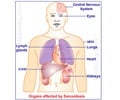Doctors who treat patients suffering from lymphangioleiomyomatosis, a progressive respiratory disease could have to face an agonizing treatment decision

"It's a terrible situation," said pulmonologist Dr. Daniel Dilling, medical director of Loyola University Medical Center's LAM Clinic and Lung Transplantation program.
The Food and Drug Administration has issued a "Black Box" warning about the use of sirolimus in lung transplant patients, at least when started at the time of transplantation. Many physicians therefore do not use the drug in LAM patients once they go on the transplant waiting list, since it is uncertain when the operation will occur.
But a physician survey, an animal model and information about how the drug is metabolized suggest that a drug similar to sirolimus may be an option for LAM patients, according to a presentation Dilling made during the 34th Annual Meeting and Scientific Sessions of the International Society for Heart and Lung Transplantation in San Diego.
LAM occurs almost exclusively in women. An abnormal growth of muscle cells invades the lungs, eventually causing airways to become obstructed. Symptoms include shortness of breath, chest pain, chronic cough and pneumothoraces (lung collapses). As the disease progresses, many patients will need to go on oxygen, and some will require lung transplants.
LAM is uncommon, but not as rare as once thought. As many as 30,000 to 50,000 women worldwide may have the disease, according to the LAM Foundation.
Advertisement
Sirolimus sometimes is given to lung transplant patients to prevent rejection. But two studies found that sirolimus caused a serious and sometimes fatal complication called anastomotic dehiscence, which impairs wound healing if the drug is given around the time of the operation. Consequently the connections where the donor's lung are sutured into the recipient break apart.
Advertisement
However, some LAM physicians have begun prescribing everolimus (Zortress®), which has a shorter half-life. Once a patient undergoes a lung transplant, the patient is immediately taken off the drug. In an informal survey, Dilling found that physicians who have used this strategy report no dehiscence problems. Moreover, a recent animal study at the University of Cincinnati found that if sirolimus treatment ceased immediately, wound healing was not impaired. And an earlier study of pulmonary fibrosis patients who took everolimus found that among 11 patients who had lung transplants, there was no increased incidence of wound-healing/anastomosis problems.
Historically, Loyola physicians have not prescribed rapamycin-class drugs to LAM patients who are on the waiting list for lung transplants. "However, in light of recent evidence and experience, we are reconsidering this policy," Dilling said.
Laura Lentz, chair of the board of directors of the LAM Foundation, said that in raising the topic, Dilling "is providing a service that is going to make a big difference for women who have LAM."
Lentz agrees with Dilling that more research is needed on rapamycin-class drugs in LAM patients. "One of the frustrations of having a rare disease is that there has not been a lot of work in this area," Lentz said. "There are more unknowns than if this were a common disease."
The LAM Foundation seeks safe and effective treatments, and ultimately a cure, for LAM through advocacy and the funding of promising research. The foundation serves the scientific, medical and patient communities by offering information, resources and a worldwide network of hope and support.
Loyola has been designated a Center of Excellence by the LAM Foundation since 2010. Dilling cares for 50 LAM patients, one of the largest groups of LAM patients at a single center in the world.
Source-Eurekalert












